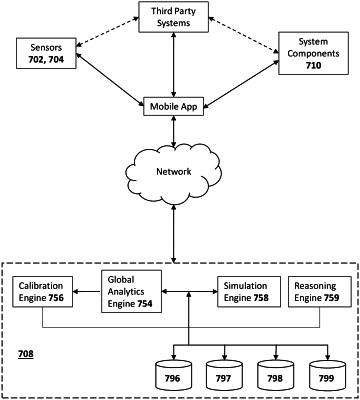| CPC A61B 5/4812 (2013.01) [A61B 5/02055 (2013.01); A61B 5/1118 (2013.01); A61B 5/4815 (2013.01); A61B 5/4884 (2013.01); A61B 5/681 (2013.01); A61M 2021/0066 (2013.01)] | 20 Claims |

|
1. A system to reduce stress and promote sleep comprising:
at least one remote device;
at least one remote server; and
at least one body sensor, wherein the at least one body sensor includes a heart rate sensor;
wherein the at least one remote device is in network communication with the at least one remote server and the at least one body sensor;
wherein the at least one remote device collects body sensor data from the at least one body sensor;
wherein the at least one remote device is operable to analyze the body sensor data, thereby creating analyzed body sensor data;
wherein the analyzed body sensor data includes at least a resting heart rate and a heart rate variability;
wherein the at least one remote device is operable to estimate sleep stages from the body sensor data and/or the analyzed body sensor data;
wherein the at least one remote device stores a chronotype for a user;
wherein the at least one remote device classifies a user into at least one group based on a user profile, the body sensor data, and/or user provided information; and
wherein the at least one remote server is operable to run at least one algorithm to suggest at least one intervention to the user to reduce stress and/or promote sleep based on the user profile, the body sensor data, the analyzed body sensor data, the chronotype of the user, and the user provided information;
wherein the at least one remote server includes a global analytics engine, a simulation engine, and a calibration engine;
wherein the global analytics engine is operable to generate predicted values for a monitored stress reduction and sleep promotion system using a virtual model based on real-time data;
wherein the simulation engine is operable to generate optimized values of the monitored stress reduction and sleep promotion system based on real-time data and user preferences;
wherein, based on the output of the simulation engine, the global analytics engine determines if a change in parameters of the system is necessary to optimize sleep; and
wherein the calibration engine is operable to modify and update the virtual model with new parameters.
|